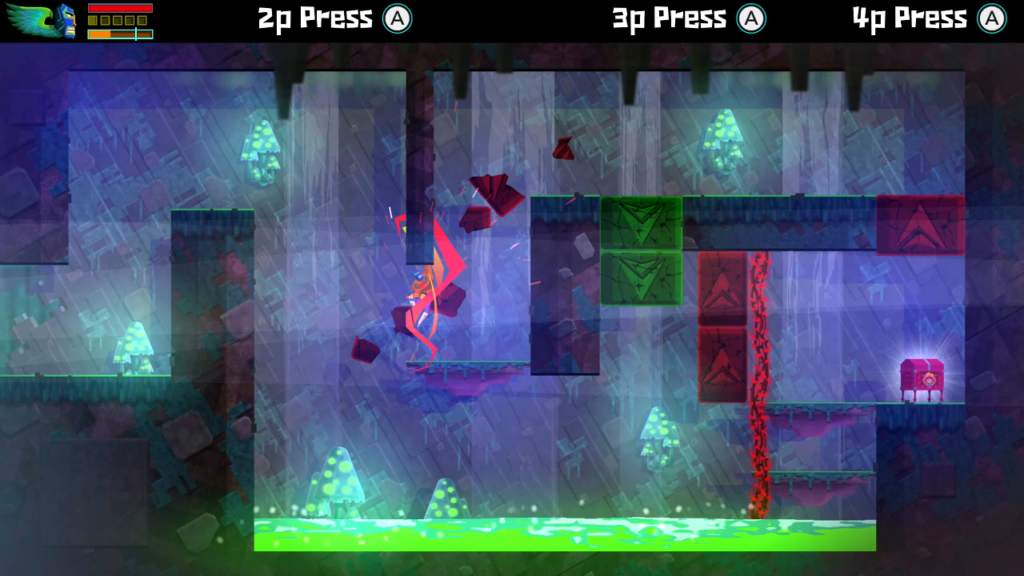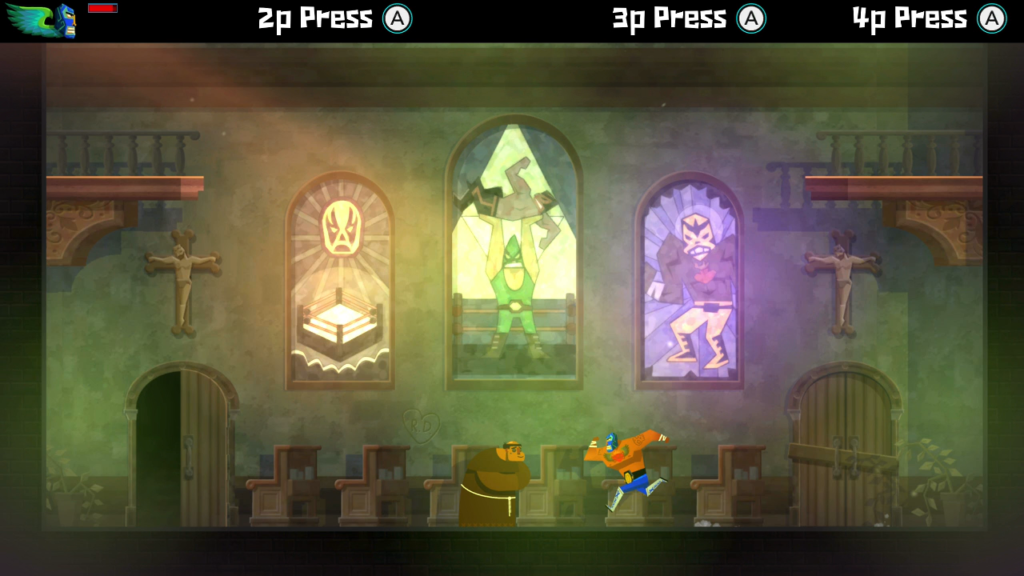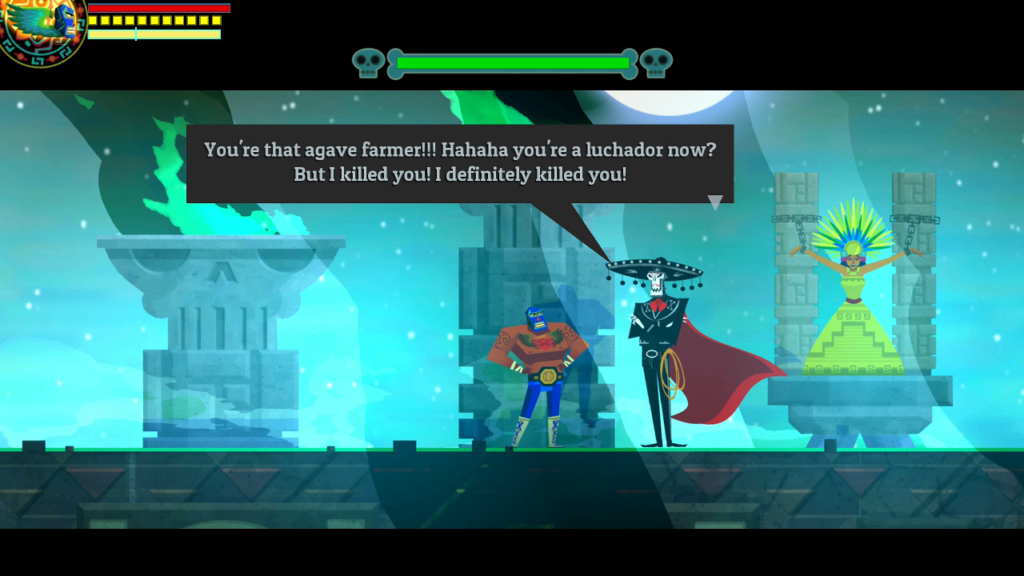Guacamelee! is a lucha libre-themed non-linear platformer about Juan Aguacate, a lovesick agave farmer, whose sweetheart, referred to only as El Presidente’s Daughter, is kidnapped by a villainous undead charro named Carlos Calaca. Carlos is newly returned from the Land of the Dead with world-conquering plans that include El Presidente’s Daughter, and when Juan tries to interfere, the farmer is effortlessly killed. Arriving in the Land of the Dead, Juan is gifted a magical mask that lets him return to life with the physique and abilities of a luchador. I play as Juan as he uses his magically-empowered wrestling skills to traverse Mexico’s Living and Dead halves, defeat Carlos Calaca and his minions, rescue El Presidente’s Daughter, and save the world.

Due to being built around lucha libre, a form of professional wrestling with deep roots in Mexican culture, Guacamelee! is especially combat-focused for a non-linear platformer. It accomplishes this by embellishing its combat systems beyond much more than basic attacks. These expanded systems are detailed enough that Guacamelee! feels as much like a beat ’em up as it does a non-linear platformer focused on exploration and character upgrades.
At first, Juan feels similar to other non-linear platforming protagonists through his prodigious abilities to jump and execute fast, simple attacks. Hitting enemies with a basic punch enough times causes them to stagger, and this is where the combat systems become more complicated. Staggered enemies may be grappled with a button press, then tossed into the walls, ground, or other nearby enemies. This becomes a vital crowd-control skill, particularly on the unlockable Hard difficulty, as enemy groups become unmanageably large. Tossing one enemy into a pack of others is a good way to damage the entire group and clump them together so they may all be hit by the next attack.

As Juan explores Mexico, he learns new wrestling skills like the Rooster Uppercut and the Olmec Headbutt. These may be chained from basic attacks and grapples, and when used in midair, even allow Juan to reset the limits on his basic attack combo. As I become more skilled in these combat systems, I learn to hit enemies with a basic combo, toss them into the air, pursue them with a Rooster Uppercut, continue the combo, throw them again, pursue with another of Juan’s special skills, and so on until an enemy’s hit point meter has been pummeled into nothing. It’s an effective encapsulation of the high-flying, theatrical wrestling spectacles that typify lucha libre, expanded to gravity-defying superhuman heights thanks to Juan’s magical luchador mask and the medium of a videogame.
Combat is such an integral part of Guacamelee! that, aside from the usual bevy of enemies which appear across the world’s platforms to serve as obstacles between the player character and his goals, Juan often finds himself sealed in small spaces when he tries to move into new territory. These sealed spaces serve as makeshift rings for impromptu wrestling matches, tasking Juan with defeating multiple enemy waves to open the path forward. Some of these arenas contain Guacamelee’s greatest challenges where many powerful enemies in unusual combinations attack in hazardous scenarios.

To give Juan an edge in these especially difficult battles, I am encouraged to invest a great deal of my playtime in the time-honored non-linear platforming tradition of collecting character upgrades. By using moves like the Rooster Uppercut and the Olmec Headbutt, as well as more traditional abilities like the double jump, I can help Juan find collectibles which improve his statistics. Three skull fragments give him another point of stamina, the resource that powers his special wrestling skills. Three heart fragments grant him an extended life meter.
Guacamelee! stands apart from other non-linear platformers by making the location of these heart and skull fragments the easy part of reaching them. Rather than hiding secret passages behind scenery or through subtly-different walls which may be destroyed when attacked, most passages are in plain sight but sealed by brightly colored blocks. Each block may be destroyed by a specific ability. Blocks are added to the map as Juan passes by them, making it easy to backtrack once he has the ability needed to bypass it and claim the reward it protects.

Bypassing the sealing block is only the first step to accessing its protected reward. To reach the chest on the other side, I often must guide Juan through an obstacle course, utilizing many of his skills in succession, demanding perfect timing and creative application of all his skills to reach the prize. These single-screen rooms represent Guacamelee!’s platforming at its finest and are its best contributions to non-linear platforming design. They transcend upgrading the player character beyond a familiar exercise in backtracking. To obtain the upgrade, I must utilize the player character in an expression of true skill. Every heart and skull fragment is earned with talent and tenacity, not rote memorization or a wiki walkthrough.
For Guacamelee!’s final platforming flourish, Juan learns how to shift between the Land of the Living and the Land of the Dead at the press of a button. This shift is accompanied by impressive changes in art and sound design. The Land of the Living is filled with warm, bright oranges and reds, while the Land of the Dead uses moodier, darker purples and blues—though notably not outright spooky or menacing because this culturally Mexican afterlife is not a scary place to exist. The Spanish horns and guitars that accent most areas play in upbeat, almost dance-like tempos in the Land of the Living, then shift to a slower and dreamier mix with echoing instrumentation in the Land of the Dead.

Before playing Guacamelee!, upon hearing of this shifting mechanic, I would expect to encounter familiar “Parallel Worlds” design tropes. I would expect that two versions of a similar world map would be traversed. These two versions would be identical at a glance but with subtle differences between them, making them separate and distinct. My success is determined by my knowledge of these subtle differences, with details in one map revealing paths in the other, creating puzzles and routes that interweave between both worlds.
Guacamelee!’s Land of the Living and Land of the Dead are not separate and distinct. They exist in almost the same space, their proximity illustrated by making both halves visible once Juan learns how to shift between them. Objects in the other Land are intangible, visible only as silhouettes. With the press of a button, Juan shifts between Lands, the intangible becomes tangible, and what was once a secure platform beneath his feet may have suddenly disappeared. Some of Guacamelee’s greatest platforming challenges utilize this mechanic to great effect, demanding that Juan shift with perfect timing, leaping from a platform that exists in the Land of the Living to one in the Land of the Dead.

As should be clear by now, Guacamelee! is steeped in Mexican culture and language. At first I am comfortable letting this exist without comment. Then I spot something in the end credits that gives me pause: “Made possible with the support of the Ontario Media Development Corporation.” This leads to my awkward realization that Guacamelee!’s developers are Canadian.
I do not believe a Canadian developer is incapable of producing an authentically Mexican product, or that it is impossible for them to have Mexican creatives despite their Canadian locality. I do believe it would be lazy of me to not at least describe how Mexican culture is portrayed, even if I am personally unable to evaluate how authentic or sensitive these portrayals are.

Some of the culture portrayed here feels distinctly Mexican-American. I see this most clearly in how every character speaks fluent Spanglish, dotting their English with occasional Mexican Spanish nouns and adjectives. This also applies to some of the intended jokes, which build themselves around recognizable references and exaggerated pronunciations.
Juan Aguacate’s name translates literally to “John Avocado.” One of his allies is Fray Ayayay, a name that demands to be pronounced like it is coming from The Simpsons’ Bumblebee Man. One NPC comments about earning a degree in “Jumanities,” a joke that only works when the “j” is pronounced with a hefty “hayche” sound. Carlos Calaca’s most enigmatic henchman has a name with a similar function: Jaguar Javier.

Some elements are eye-rollingly obvious, as though the justification for their presence is “because Mexico.” When Juan is victorious in an arena fight, he must break open a piñata to receive his reward. One sidequest involves reuniting the disparate members of a mariachi band. Non-player characters and even many monsters are decked out in colorful sombreros, ponchos, and sarapes. Maybe these are all authentic representations of Mexican culture. I recognize them more as the accoutrement of a Cinco de Mayo office party in the United States, and so I struggle.
I believe Guacamelee! desires to be affectionate in its exploitation of Mexican culture, though I am not sure if it is wholly successful. While playing, the thought constantly exists in the back of my mind: “If I keep wondering if something is offensive, then it probably is.” The fact that I instinctively describe its application of these cultural customs and artifacts as “exploitation” is troubling to me.

I may gain some insight into how Guacamelee! utilizes its Mexican cultural influences by looking at another aspect of its humor: videogame parodies.
The most readily available version of Guacamelee!, the Super Turbo Champion Edition, is itself a joke, referring to the many, many infamous updated re-releases of Street Fighter II on consoles in the early 1990s. Recalling his non-linear platforming roots, Juan gains new abilities by smashing Choozo Statues. Referencing another classic Nintendo videogame, Juan defeats an invulnerable Alebrije by destroying the bridge it stands on with an axe. Steeped as I am in the culture of videogames, I am much more confident saying these parodies are affectionate. If the developers are this successful in this aspect of Guacamelee!’s humor, it makes it more likely they are successful in another.

As Jorge Albor says in his Kotaku article asking the very question I am grappling with, “We are better off asking: What does the game do right? What does the game do wrong? And is the game made with care?” As goofy as some of Guacamelee!’s jokes about Mexican culture can be, I do not feel they are malicious. There are no jokes about drug cartels, anchor babies, or border walls to be found here. Nothing here makes me cringe. It makes me wonder, “wait, is it okay that I chuckle at this?”
I cannot say the jokes are right, but I am more certain that they are not wrong. This suggests Guacamelee! was made with care, and for that its humor has my cautious admiration.

Setting aside my indecisive feelings about its sense of humor, Guacamelee! is worth playing for its unique take on non-linear platforming. By making Juan’s abilities equally as useful in combat as they are in platforming, the combat is transformed. It’s satisfying to be aggressive and combo-based when fighting enemies, a tactic that’s usually a death sentence in the genre. Adding platforming challenges as barriers to most of the upgrades is equally as transformative, shifting my focus from exploring the world with thoroughness to exploring it with skill. Guacamelee! is a fantastic change of pace for players who want to add some beat ’em up spice to their non-linear platforming.